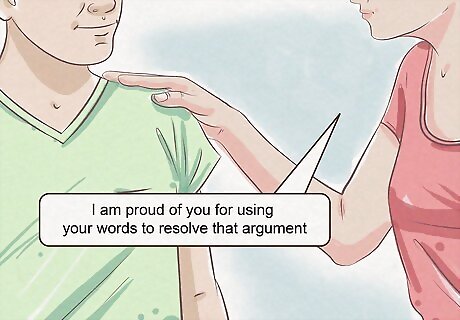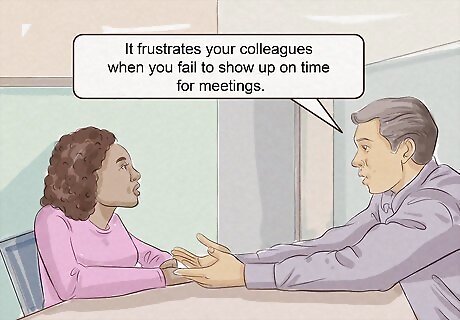
views
Making Positive Statements

Start with a compliment. Begin the conversation by saying something positive to the other person. You want to start this talk on a positive note. It will help keep the other person from becoming defensive. You might say, “It’s great that your sales have increased since last month.”

Be specific. Make sure that your compliment is not vague. That might leave the other person feeling like your feedback isn’t directly applicable to them. Include direct statements about their performance. Tell your son, “Thomas, I am proud of you for using your words to resolve that argument with your sister.”

Be sincere. Don’t compliment someone just for the sake of it. You risk coming off as phony and damaging your credibility. Find something that you honestly feel the person did well to talk about. You could say, “John, you’ve worked really hard to make your emails more polite. All of your team members really appreciate it.”

End with an encouraging statement. You will also wrap up your talk by offering some additional positive words. This is the second piece of bread in the feedback sandwich. This helps ensure that the conversation ends on a positive note. Try saying, “Amy, you’re off to a great start with this paper. I’m looking forward to helping you develop that thesis statement.” You can also reiterate your first positive statement. For example, “Again, I can really tell that you are making an effort to craft more constructive emails.”
Giving Ways to Improve

Offer constructive criticism. Do not just tell the person what they are doing wrong. Constructive criticism means that you also need to provide some ideas on how they can improve. Tell them what they are doing wrong, then tell them how to fix it. You can say, “Your sales are nearly 20% below your target, and you have not met your goals for the past three months. Let’s work together to expand your network and improve your pitch.”

Be direct. Do not try to dodge the issue. Get straight to the point. After your positive statement, deliver the feedback in clear, straightforward terms. Say, “You need to improve your sales in the next month, or we will have to rethink your role on the team.”

Be brief. Don’t ramble on. Your statement should be direct, and it should also be brief. You’ll be able to follow up on the issue later. During the feedback sandwich, keep it short so that your message is easy to understand. If you were to write out your feedback, the “filling” would probably not be longer than a paragraph.

Give clear guidelines. The point of giving feedback is to help the other person succeed. Avoid telling them vaguely what you need from them. Instead, give specific goals to meet. You could say, “You need to meet your sales goals every month. Let’s work together to adjust your target until you are able to meet your original goal. We will need to meet each week to discuss your progress.”
Providing Effective Feedback

Be objective. Avoid using “I” statements. These are things like “I don’t like how you did this” or “I feel like you are not trying”. Instead, use actual facts to support the points you are making. Say, “You have not turned in the past three assignments. That demonstrates a lack of commitment to this class.”

Focus on the situation instead of the person. Leave your personal feelings out of it. Sure, you might feel some negativity towards the other person, or maybe you just don’t click. Don’t let that inform the criticism that you are giving. Instead of saying, “You’re not helping the team” try saying, “It frustrates your colleagues when you fail to show up on time for meetings.” Avoid criticizing the person's character or motives.

Give task specific suggestions. Try to avoid giving vague suggestions for improved performance. Something like, “You need to do better” is not really helpful. Instead, talk about the actual thing that needs improvement. Make your feedback actionable. Give the other person tangible things that they need to do. Instead of “You need to help more around the house” try “You need to make your bed and feed the dog every morning before school.”

Give timely feedback. Try to give your feedback when it can still be helpful. If you wait until you are completely dissatisfied, there might not be much time left to salvage the situation. If you notice a problem, address it quickly. If given correctly, your feedback could help the other person improve. Don’t wait until a student has failed your class to give feedback. Instead, discuss ways they can improve throughout the semester.
















Comments
0 comment